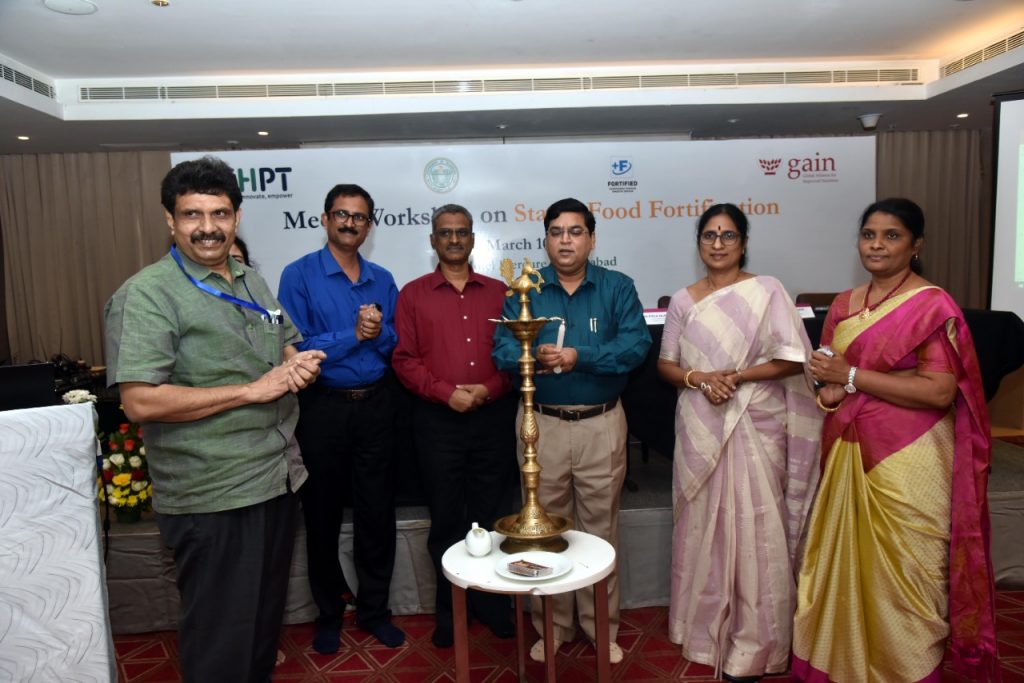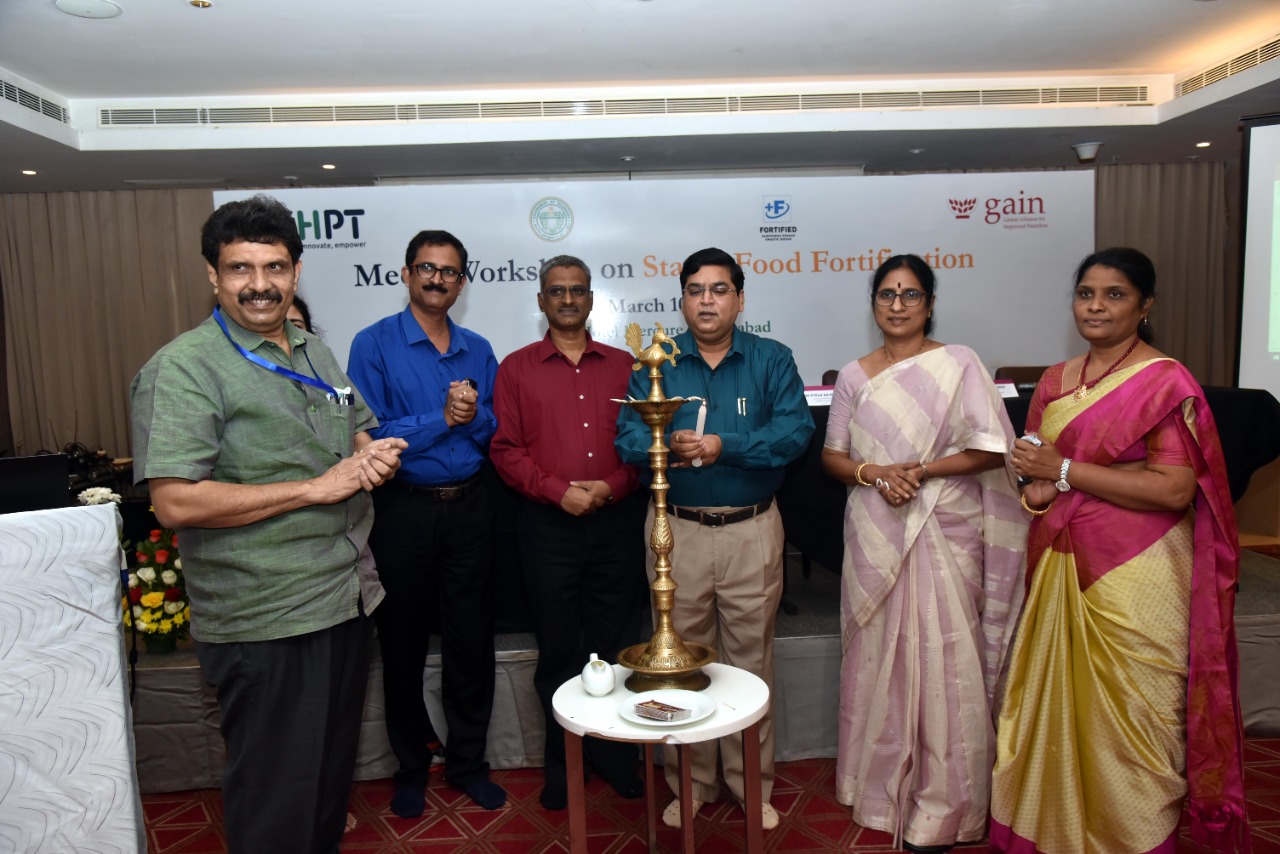
HYDERABAD: In a media briefing organized by the Karnataka Health Promotion Trust (KHPT), supported by the Global Alliance for Improved Nutrition (GAIN), and in collaboration with the Food Safety Division, Government of Telangana, experts detailed on the benefits of food fortification and the urgent need for its widespread adoption.
Dr. K. Shankar, Director, Department of Food Safety, Government of Telangana and Mr T Vijay Kumar, Deputy Food Controller, Department of Food Safety, Government of Telangana were the Chief Guests. Also present were Troy Cunningham, Thematic Lead, Maternal, Neonatal and Child Health, KHPT, Ms T M Usha Rani, Consultant, Fortification KHPT, Ms Ruchi Sareen, Senior Project Associate, Food Fortification Programme, GAIN India. The technical session was taken by Mr. Gururaj Patil, Team Lead, Fortification, KHPT.
Speaking on the occasion, Dr K. Shankar, Director, Department of Food Safety, Government of Telangana said that the media has a crucial role to play in spreading public awareness about fortified food. He added, “In developing countries like India undernutrition is still markedly recorded… a lot of manufacturers are coming forward to fortify milk and edible oils, but it is for the media to highlight that and make consumers aware.” He also noted that rice fortification is being done and the civil supplies department was collaborating on this. This, he felt, will supplement the nutrition to children and pregnant women of the State.
Mr T. Vijay Kumar, Deputy Food Controller, Department of Food Safety, Government of Telangana added, “Food fortification is going to be mandated by FSSAI in the upcoming future. Keeping this in view, in December 2020 there was a special training programme for all FSSAIs and newly recruited FSSOs of Telangana State. Nearly 35 FSSOs were recruited, and all are trained… I take this media sensitisation programme as a platform and request all media people to take this wonderful opportunity to help Telangana State to penetrate each and every household and make the public aware of what is food fortification and what wonders it can do.”
In food fortification, micronutrients (vitamins and minerals like Folic acid, Vitamin B12, Vitamin D, etc) are added to staple foods like rice, wheat flour, milk and edible oils. Micronutrient deficiency results in poor cognitive and learning abilities in children and overall, lower productivity, increased morbidity, and mortality and lower immune responses.
Data from the first phase of the National Family Health Survey-5 (NFHS-5), covering 17 states and five Union Territories, showed a worsening in indicators related to nutrition such as anaemia and Vitamin D levels in many states. Child stunting increased in Goa, Kerala, Telangana, Gujarat, and Maharashtra. Wasting became worse in states/UTs like Kerala, Ladakh, and others. Over half of children and women in 13 of the 22 States/UTs were found anaemic and among pregnant women increased in half of the States/UTs compared to NFHS-4.
Between NFHS-4 and NFHS- 5, in Telangana, the percentage of underweight children went up from 26.6% to 28.9%, that of anaemic children from 60.7% to70% and the percentage of anaemic women rose from 56.6% to 57.6%.A high prevalence of undernutrition is seen in both rural and urban areas.This is particularly so in the state’s sizable tribal population. A study[1] on children under 5 and their mothers from the Chenchu tribe found that 42% of the children were underweight, 53% were stunted and 13% suffered from wasting. The nutrient intake was below recommended levels. Moving to the urban picture, a recent study[2]in Hyderabad showed a higher prevalence of micronutrient deficiencies among urban adults.
India’s Public Distribution System is largely grain-dependent (rice and wheat) and these do not provide adequate protein and micronutrients like Vitamin A and D, the absence of which can contribute to malnutrition and increased vulnerability to diseases. Many beneficiaries of the food programmes are too poor to buy protein-rich foods, leafy vegetables and fruits that provide micronutrients. Fortification is a proven, cost-effective scientific solution that can be scaled up.
Nutrition is a key focus area of the National Development Agenda (concerning the Global Sustainable Development Goals – SDGs). The Food Safety and Standards Authority of India (FSSAI) is framing policies and guidelines and is engaging with the food processing industry and food business operators (FBOs) for the fortification of cereals, oil, and milk with suitable micronutrients so that the fortified staples are easily available in the open market and to the state governments for distribution through the Public Distribution System (PDS), Integrated Child Development Services (ICDS) and the Mid-Day Meal (MDM) scheme.
Speaking of this Ms Ruchi Sareen, Senior Project Associate, Food Fortification Programme, GAIN Indiasaid, “Fortification of staple foods, as we all are aware, is a safe, cost-effective, evidence-based strategy to ensure that everyone, including the most vulnerable, has access to essential micronutrients. We are working towards capacitating the industry so that all the fortifiables — milk, edible oil and wheat flour, available in India, are adequately and appropriately fortified as per the national gazetted standards.” Adding to these thoughts, Mr. Gururaj Patil, Team Lead, Fortification, KHPTsaid, “In India, the government has taken several measures to make food fortification a norm. The FSSAI has proposed to make retail edible oil and milk fortification mandatory across the country. Efforts are being made to provide quality assured fortified staples to all beneficiaries of social safety net programs. These efforts, if intensified and scaled up, have the potential to address the chronic micronutrient deficiencies plaguing large sections of the Indian population. The media can play the role of a catalyst, by building awareness about the benefits of fortified food among the people and contributing to increased demand and consumption.”
The packaging of fortified products will carry a blue +F logo and the nutrition label on the packed product would indicate the various added micronutrients and their quantities, as specified by the FSSAI. Non-fortified products cannot use this logo.


